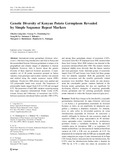| dc.description.abstract | International potato germplasm (Solanum tuberosum L.) has been long introduced to and bred in Kenya and the accumulated Kenyan Solanum germplasm is unique in its geographical and climatic ranges of adaptation to tropical highlands. However, little is known about the genetic diversity of these improved Solanum accessions. A representative set of 48 potato accessions grouped as farmer varieties, local genotypes and modern varieties was selected and studied using the simple sequence repeat (SSR) technique. Twenty-two SSR primer pairs were applied and 122 polymorphic bands were scored. The frequencies of polymorphic bands ranged from 0.02 to 0.98 and averaged 0.35. The proportion of total SSR variation occurring among four origin categories (International Potato Centre (CIP), Europe, Kenya and Unknown) of accessions was 6.32%; between accessions introduced before and after 1980 4.79%; and among three germplasm classes of accessions 4.36%. Accessions from the CIP displayed more SSR variation than those from Europe. More SSR variation was detected in the accessions introduced/bred after 1980. The modern varieties displayed slightly more diversity than the farmer varieties and local genotypes. Some dominant groups of accessions largely from CIP and Europe were found, but these groups were not distantly separated. Both the genetically most distinct accessions and the possibly genetically related accessions were identified. These results not only demonstrate the considerable genetic variation harbored in the Kenyan potato germplasm, but also are significant for developing effective strategies of acquiring genetically diverse germplasm and for selecting genetically distinct potato materials to widen the Kenyan improved gene pool. | en |

